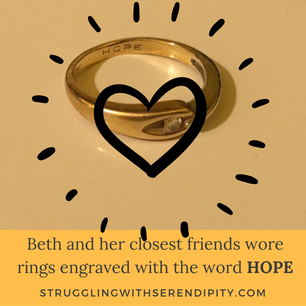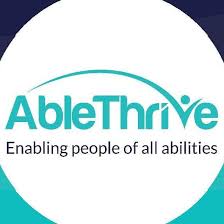 (This blog tells my family's story. To see more, click "blog" at the top of this webpage.) Beth and her closest friends wore their new HOPE rings every day. I wondered about the different meanings of hope. For her friends, perhaps the hope of her walking again? For Beth? Probably the generalized hope for a happy future. And for me? Small, specific hopes like fewer infections and fewer antibiotics. Anything more could be wishful thinking. The physical trauma of Beth's injury had weakened her immune system. Through the first several months, there was always a health issue that I worried about, either increased congestion or coughing or fever or infection or nausea or spasms or swelling. "I began high school as a different person than I was in junior high." A rare intense storm ushered in the first morning of school, complete with hard driving rain, lightning, thunder, and high winds. I parked near the new automatic doors, pulled the wheelchair from the trunk, unfolded the seat, plopped the cushion on, zoomed to Beth’s open door, scooped her legs over the doorway, grabbed the outside seam of her pants, and lifted her to the wheelchair. The umbrella Maria held over us broke, so when the girls entered the building, they left a trail of water down the hall. I had a meeting scheduled with my supervisor for my new job, but I rushed back home first to change out of soaked clothes, frazzled and sick to my stomach. After my meeting, I had a list of immediate things to do for the employment office to start work the next day. Back at the high school at lunchtime, I could breathe easier when I found a smiling Beth waiting for me. I was relieved to hear that she had a good morning. "Kids stared a lot at first. They wanted to get my attention, to talk to me, to see how I had changed," Beth said. "I was already used to being stared at. They thought they would offend me by confirming that I use a wheelchair, as if I didn't know." She looked more pale than usual, completely drained. Beth’s low back ached, a result of the strand of sensation that remained connected to her spinal cord. I suggested leaving early with me for home—a futile request.
4 Comments
 (This blog tells my family's story. To see more, click "blog" at the top of this webpage.) Beth arrived home to the realities of an inaccessible world. She wasn’t strong enough to wheel herself up the low incline of our new ramp and expended colossal effort to open the refrigerator. Her livable space shrunk without the second floor and basement. I hated our small bathroom and our new shower chair. Nothing was easy. I desperately wanted to make things better and suggested moving to a more accessible home. She insisted that we stay put, and I resolved to try harder. Three days later, Beth’s African Gray baby arrived to stay. The parrot stood nearly a foot high with striking gray and white shading. She named him Timber since he could not perch well, sometimes falling from a hand to a lap (tim-berrrr!), and because she had a crush on Justin Timberlake from N’Sync. A typical fourteen year old in many ways, my youngest wanted to look her best for the start of school. A dentist put a cap on her chipped front tooth from the accident. Beth asked for a haircut and her first highlights. When we went shopping with Maria, a lady asked about her sister’s wheelchair. “Some people assume I’m not intelligent because I am in a wheelchair,” Beth said. “They talk loud and slow when they first see me. When I do normal things such as moving around or crossing a threshold, some people will tell me ‘good job!’ like it is the most amazing thing.” Beth's friend Elizabeth (and Elizabeth’s mom) surprised her with an extraordinary gift, an elegant silver and gold ring with a small diamond, engraved with the word HOPE. Her five closest friends wore identical rings. The friends planned to pay for the rings until the Osterman Jewelers in our small Ohio town, Tiffin, donated them instead. When I dropped off a paper to the high school principal that explained quadriplegia, he offered me a part-time position in a program for at risk students. There wasn’t any other job I could do and be available to Beth, so I accepted. I hurried away, suddenly winded with a tightening chest, thudding heart, throbbing head, and dizzying view. Why did I say yes? I had none of Beth’s courage. How much would she need me? How many school days would she miss? My responsibility had doubled, tripled, without the safety net of rehab nurses. Anything could happen and I worried about everything.  (This blog tells my family's story. To see more, click "blog" at the top of this webpage.) Beth’s days in the rehab hospital focused on long physical therapy sessions. It didn’t seem fair that it took so very long for her damaged muscles to respond in some slight way. At Beth’s follow-up with the surgeon, we viewed her latest x-ray, a side view of the neck that showed 6 screws instead of 12 holding the large titanium plate; the other set of 6 lined up perfectly behind. In spite of the doctor’s impressive surgical skills, Beth’s motor function remained absent below her level of injury, complete. The muscles in her hands and legs began to shrink, unattached to her spinal cord. No leg movement, besides spasms. No bearing weight on her legs. No standing. No walking. No request for mechanical braces or experimental treatments. No envy of those with expensive equipment, such as standers, or those who spent hours strapped to bicycles and other machines. And no waiting for a miracle. Beth was eager to start her freshman year of high school on time with her friends. On discharge day in early August, she hugged the nurses and aides goodbye, but not her therapist friends. She would continue to work with them three times a week in outpatient therapy. Beth could sit in her new blue wheelchair without feeling dizzy and pushed the big wheel rims to slowly move forward. With taxing exertion, she rolled her body on a flat bed to get more comfortable or to attempt getting dressed. Weak and wobbly, she sat up by herself and put her shoes on and off, though she couldn’t tie the laces. With effort, Beth could shift her bottom on the wheelchair cushion to prevent pressure sores. She ate and drank mostly on her own and kept trying to use her hands. She moved from the wheelchair to the bed more easily—with total help and a wood sliding board, newly made by my dad. “I was in another world at St. Francis," Beth said."Wheelchairs were the most common sights, everyone was completely accepting, and nothing about my injury seemed out of the ordinary. High school was different.” When we left the hospital room behind on a sunny August day, it felt like a fresh start. I returned Beth’s smile, hiding my apprehension over what the future might bring. The titanium plates had fused to fragments of bone, so she no longer needed the neck brace. She tilted her head a little towards the open car window, happy, as we turned up the radio and drove away on the country road towards home. A co-dependent team, we plunged into uncharted waters together.  (This blog tells my family's story. To see more, click "blog" at the top of this webpage.) At the rehab hospital, Beth and I took turns reading aloud in the evenings from the new Harry Potter book, Goblet of Fire. She could hardly hold the book, even though it rested on a small table over the bed. At first, turning pages was impossible and we used clothespins to keep the pages open. We put a fat tube around a pencil so she could use the eraser end to turn a page. That worked until she eventually figured out how to accomplish the job with just her hands. She somehow sustained an easygoing attitude about almost everything. It suddenly became imperative that the bottom of her jeans covered her ankles when she sat in a wheelchair. Immediately after a transfer, I grabbed the extra fabric at her knees and pulled it down so the bottom hem touched her shoe. Then, at her request, I adjusted it again. Fourteen years old, she also added these steps to the ending routine in physical therapy. “Beth worked long hours in rehab,” Laraine said, “learning to move about in her wheelchair and moving from place to place from her chair. To do these tasks, innervated muscles need to be very strong and much of her day was spent weightlifting and exercising.” The physical therapists and aides became trusted friends. However, the hospital director was an expert on strokes, not spinal cord injury. “The director told me that I should never get in a pool,” Beth said, “because my body would go into autonomic dysreflexia—my blood pressure would shoot up, my temperature would rise, and I could have a stroke. Luckily, my physical therapists disagreed with the doctor, but I had to wait until I was an outpatient to try their heated therapy pool.” The hospital director also insisted that everyone with a spinal cord injury should need help for depression, so Beth agreed to meet with a psychiatrist. After two sessions, she asked if she had to keep talking to him. He told her she was in denial about her disability! ...which didn’t make any sense to me, since she talked openly about her injury and asked about details. It amazed me how easily she dismissed the psychiatrist’s judgment as a minor nuisance, with no need to argue or to change his mind. He seemed a little distressed because she didn’t experience set stages. Looking back, it's clear to me that everyone in my family struggled to accept her injury—all of us, that is, except for Beth. A newspaper reporter wrote: Pressed if she has ever asked, “Why me?” Kolbe said, “No, I never did. I never did the whole grieving process thing. I was too busy during rehab. I had great physical therapists.”  (This blog tells my family's story. To see more, click "blog" at the top of this webpage.) Beth’s decision to leave the rehab hospital early ramped up preparations for her return to home and school. At a July meeting with staff at the high school, she expressed no concerns about her first year in the sprawling building or her inability to do almost everything. I obsessed over every detail, trivial or not. I planned to meet Beth at school over her lunch break, so I requested a cot. A storage closet with an attached bathroom was converted into her private locker room. It included a small vinyl mat table. I also would be on call before and after lunch, so I signed our first contract for cell phones, ready with speed dials. We dropped physical education and band (trumpet) from Beth’s schedule and added two study halls, including one at the end of the day that she could skip to leave early. Three afternoons a week, we would drive straight from school to physical therapy in Green Springs with Laraine. Beth would not need to stay late at school for volleyball team practices and games, as we had planned before her injury. Her last weeks in the rehab hospital, John and I converted our living room into a first-floor bedroom. He removed the carpet and put down linoleum so the floor would be easy to wheel on. I bought a hospital bed and a cumbersome shower chair with rails for our one small bathroom. There wasn't enough time to build a bigger one. I tried to focus on anticipating what Beth would need, but my guilt over causing her disability would not be ignored. Averse to pity, I avoided everyone except my family. Even with my husband and children, the last thing I wanted was to cause them more worry. I made a heroic, but ultimately futile, attempt to bottle up my emotions. Planning for school turned out to be easier than going to school.  (This blog tells my family's story. To see more, click "blog" at the top of this webpage.) Beth decided to cut her stay short at the rehab hospital to start her first year of high school on time. The inpatient stay for those with new spinal cord injuries in the neck often exceeded three months. She would leave her hospital room after two months, giving her two weeks at home to adjust before school started. She refused to weigh the merits of the easier option: tutoring. No matter that she was pale, tired, weak, and susceptible to infection. No matter that she could wheel herself a short distance before her arms trembled and exhaustion set in. "Life is about making choices," Beth said. “At this point, some people may have taken a year off of school to rest and build their strength at home. I wanted to start at Tiffin Columbian High School with the rest of my freshman class.” I was faced with a choice as well. I officially quit my job at the institution for what I thought would be a long-term role as my daughter's personal care assistant. One afternoon in early July, John stayed with Beth while I turned in my keys and set up the literacy program for whoever would replace me. At the center, I ducked into a little-used hallway and closed myself in my office, avoiding the dozens of residents I had worked with. Most had looked forward to our sessions, usually a pleasant reprieve from monotonous days. I justified walking away, since my other option, talking individually with many residents in different locations, would be disruptive and frustrating all around. And with staff quitting regularly for easier jobs, residents lived with a revolving door of workers who cared about them. However, there was no comfort in the fact that I would not be the last to leave. As I left behind a good job where I could make a small difference, I wiped away more tears. Beth's shortened hospital stay added a sense of urgency to the rest of the summer. Extensive preparations had to be finished quickly at home–and at school. |
Cindy KolbeSign up for my Just Keep Swimming Newsletter by typing your email address in the box. Thanks!Categories
All
Archives
November 2022
|


 RSS Feed
RSS Feed











